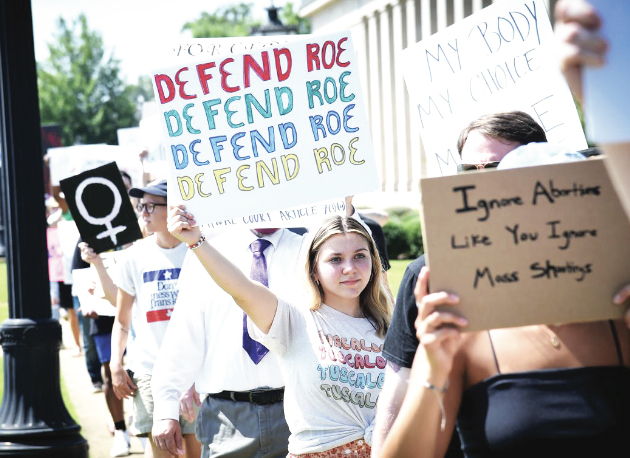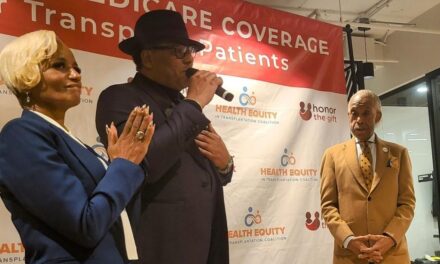Portia Shepherd has worked with about 50 teenagers in small, rural Alabama communities since March, teaching them abstinence as well as contraceptive use and personal responsibility.
“We see the difference,” Shepherd, executive director of Black Belt Women Rising, an organization chosen by the Alabama Department of Public Health to provide federally-funded sexual health programs to teenagers in Choctaw and Marengo counties. “I see students in the grocery stores giggling in aisles that sell contraceptives or parents will come to me about a discussion they have had with their kids.”
Counties in Alabama’s Black Belt have the highest teen pregnancy and birth rates in Alabama, with some rates more than doubling the state’s average. The Black Belt is rural and mostly Black and low-income, all factors that account for the disparities.
Overall, the teen birth rate in the country and in Alabama has fallen in recent decades, but Alabama’s remains relatively high. The state reported the fifth highest teen birthrate in the country for 2020.
Doctors say that could have deadly consequences after the end of legalized abortion in Alabama and many neighboring states.
“Teen birth rates are absolutely going to go up but what I’m worried about are death rates,” said Dr. Leah Torres, an OB/GYN and reproductive health specialist at the West Alabama Women’s Center. “The maternal mortality rate will go up when you have more births. That’s just math. But young people, people at those extremes of age, have a much higher risk of death in childbirth.”
Torres, who serves women in Black Belt counties and throughout the state, said she had patients – especially those who are on Medicaid or live in rural communities -on months-long waiting lists for IUDs and birth control. Often, the only option for her patients to access contraceptives is through their county health department, which can have long wait times to get an appointment. Fewer than 50% of Alabama counties have a hospital with obstetrical services, according to the Medical Association of Alabama.
Six state agencies found in a 2017 report that implementing a more comprehensive sex education curriculum and expanding federally-funded pregnancy prevention programs into schools would help decrease teen pregnancy rates.
But the recommendations were not implemented and a combination of factors, namely a state sex education standard that emphasizes abstinence, makes existing programs less effective, advocates said.
“These programs need to be in all schools and not just for the bad or at-risk kids,” said Shepherd. “A lot of things in our community are done reactively and that’s why we’re seeing [high teen pregnancy rates]. You can’t wait until after someone has had sex to teach about contraception.”
“Patchwork” services
Shortly after the U.S. Supreme Court’s decision to end federal protections for abortion, abortion became illegal in Alabama except in instances where the mother’s life is at stake. Clinics throughout the state canceled hundreds of appointments and have paused services.
While most abortions and pregnancies occur among adults, the state reported a total of 3,837 births and 5,296 pregnancies among teenagers under 19 in 2020. Within that age group, about 600 teenagers received abortions, with the youngest patient reported to be 11 years old.
Teen births carry a high risk for both the mother and the baby, and can lead to maternal mortality, premature births and low-birth weights.
The 2017 report by state agencies found that “teen pregnancy rates are significantly lower in states that offer a comprehensive sexual education program taught in schools.”
At the time the research was conducted, Massachusetts had the lowest teen birth rate in the country – 9.6 compared to Alabama’s rate of 30.1 per 1,000 teens. Researchers found that Massachusetts used $2.6 million in federal funding in both community settings and classrooms, while Alabama distributed its $2.1 million only to community organizations because of the state’s abstinence standard, according to the report.
Federal funding is the only money allocated toward teen pregnancy prevention. Alabama does not use any state funds toward the effort.
“Not all teen pregnancies are unplanned or undesired… but when they are, you see partly a failure in education and that the state does not invest in healthcare, much less reproductive healthcare,” Torres said.
Alabama schools are not required to teach sex education. When they do, students are taught abstinence, even though over 40% of high schoolers in the state have been sexually active, according to the most recent Youth Risk Behavior Survey.
A 1975 state code says that any sex education materials should emphasize that abstinence from sexual activity is the only completely effective protection against pregnancy, sexually transmitted infections and HIV/AIDS, and that abstinence out- side of marriage is the “expected social standard” for school-age children.
Those standards also note that all students should “analyze the benefits of practicing sexual abstinence,” but do not mention birth control, condoms or any other form of pregnancy or STD prevention.
Less than half of Alabama middle schools taught the health consequences of HIV, STDs and pregnancy, and only about half of high schools taught students how to use a condom correctly, according to a 2018 Centers for Disease Control and Prevention School Health Profile.
“It’s all left up to local control, so it’s very patch-work across the state,” said Christina Clark Okarmus, the executive director of the Alabama Campaign for Adolescent Sexual Health. “And unfortunately, because it’s patchwork, and because it’s not mandated, we don’t actually have a clear picture of who’s teaching what in different schools.”
According to the Alabama State Department of Education, if a teenager does become pregnant, schools do not have resources available to them, despite teen pregnancy and birth being significant contributors to high school dropout rates with only about 50% of teen mothers receiving a diploma. Instead, school districts can choose to partner with local organizations to provide literature, trainings or counseling for expectant mothers.
Options outside of schools are also limited.
The Alabama Department of Public Health coordinates the state’s teen pregnancy prevention efforts; Valerie Lockett is the head of the Adolescent Pregnancy Prevention Branch and manages and distributes federal funding to community organizations like Black Belt Women Rising.
The state received nearly $2 million in federal funding in 2021 to teach comprehensive sexual education, including pregnancy prevention, through the US government’s Sexual Risk Avoidance Education and Personal Responsibility Education programs. But ADPH only allocates that funding to community-based organizations, although an organization can partner with a school if local districts agree.
Shepherd teaches PREP courses at Amelia L Johnson and Linden high schools in coordination with Marengo County and Linden City Schools.
In 2021, ADPH selected six organizations to administer the programs in their communities, choosing entities that mostly work with at-risk youth, including teens in juvenile detention, foster care and low-income counties. But the programs are voluntary and enrollment makes up less than one percent of the state’s overall population of 989,800 children under the age of 18.
Participation sharply declined this year, falling from 2,407 teens enrolled in both federally-funded programs in 2019 to only 663 in 2021, which makes the average cost to run the programs $2,400 per SRAE participant and $3,350 for PREP.
“With COVID, that was a very large barrier because this is a face-to-face program,” said Lockett, with ADPH.
Advocates say they will continue to work with teenagers, but more resources from the state are needed.
“Teenagers especially are a very vulnerable population. They are children and do not have the same rights as adults,” Torres said. “And we are not recognizing that and we are doing everything we can actually to bring more harm to them it seems by refusing to educate them and actively preventing them from accessing health care.”
As for Shepherd, she hopes to expand these programs in her community, including in high schools, to reach more young people with their funding which runs through the next fiscal year.
“Prevention education is very important and a lot of times it’s overlooked. The more students we teach this information to, the more they can pass it on to their peers.”











